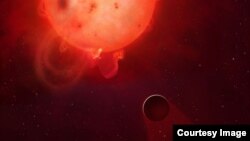An exoplanet thought to be the most Earth-like may not be habitable after all due to the large amount of radiation it receives, researchers said.
Writing in the Monthly Notices of the Royal Astronomical Society, researchers at the University of Warwick say Kepler-438b has likely had its atmosphere “stripped away” due to “superflaring” of its star, the Red Dwarf Kepler-438.
The researchers said the flaring occurs regularly “every few hundred days,” and are many times more powerful than similar flares coming from our Sun. To get an idea how strong the flares are, the researchers said they are roughly equivalent to 100 billion megatons of TNT.
But the flares alone aren’t enough to strip away a planet’s atmosphere. Coronal mass ejections, which accompany flares can strip away the atmosphere and subject it to harsh UV and X-ray radiation.
“Unlike the Earth’s relatively quiet sun, Kepler-438 emits strong flares every few hundred days, each one stronger than the most powerful recorded flare on the Sun,” said David Armstrong of the University of Warwick’s Astrophysics Group. “It is likely that these flares are associated with coronal mass ejections, which could have serious damaging effects on the habitability of the planet.
“If the planet, Kepler-438b, has a magnetic field like the Earth, it may be shielded from some of the effects. However, if it does not, or the flares are strong enough, it could have lost its atmosphere, be irradiated by extra dangerous radiation and be a much harsher place for life to exist”.
Kepler-438b is thought to be of similar size to Earth with the same temperatures.
'Earth-like' Exoplanet Likely Not Habitable
- By VOA News









